Guided by Uqualla James, Havasupai Ceremonial Caretaker, Written by Eva Willmann de Donlea
“I speak loudly because Spirit has said that I give this to you. We must hear you promise that those who are the Walkers will hear this.
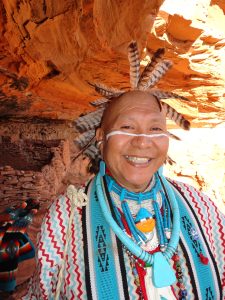
The promise was given, and this article has been written because of this promise -, so the Walkers, the Seekers, will hear about right and respectful conduct at sacred sites.
It started all quite inconspicuously over a cup of hot Mayan chocolate with my friend Uqualla in Sedona, Arizona.
Uqualla is a Havasupai, of the Blue Water People (Havsuw’ Baaja), also known as the Guardians of the Grand Canyon. Uqualla has served as their chief for many years. They are a very small tribe, by the latest census count there are just 639 Havasupai living.
Uqualla and I had been talking about the four million tourists that arrive each year in Sedona; quite a disproportionate number for a small town of just over 15,000 inhabitants.
What draws such vast numbers of tourists to Sedona?
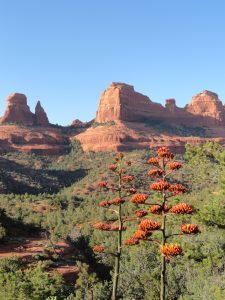 Sedona’s beauty is mesmerizing: the red rock formations and deep canyons are of equal proportions soft and wild, - lavish materializations of Nature and Spirit in an austere desert environment.
Sedona’s beauty is mesmerizing: the red rock formations and deep canyons are of equal proportions soft and wild, - lavish materializations of Nature and Spirit in an austere desert environment.
Sun and wind over millennia of time have weathered the rock into fantastic shapes, reminiscent of domes, towers and cathedrals; or eagles, angels and mystical creatures. When the shadows grow long in the afternoon, the serene buttes and domes glow deep orange and red against the clear blue skies of the high Arizonan desert.
But this beauty is not the primary draw card for Sedona tourists: According to a University of Northern Arizona study, three quarters of the visitors come “to have a spiritual experience of some kind”.
That accounts for three million Seekers; some more conscious than others of what they are seeking.
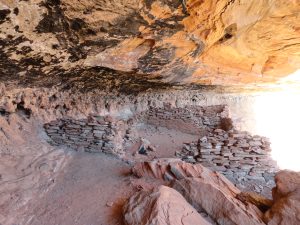 What these millions of visitors come to experience are the sacred sites and power vortices of the red-rock country. To the scientists, these vortices are geomagnetic ‘anomalies’; to the indigenous peoples they have always been ancient places of veneration.
What these millions of visitors come to experience are the sacred sites and power vortices of the red-rock country. To the scientists, these vortices are geomagnetic ‘anomalies’; to the indigenous peoples they have always been ancient places of veneration.
Though the indigenous ancestors, who originally honored these sacred places, are long gone, their traditions continue to live in the rituals of the present-day native cultures such as the Hopi, Apache, Navajo, Yavapai, and the Zuni communities.
“In the eyes of Spirit, this land always was the grand Altar of Altars. This red rock land of Sedona is considered sacred to all the indigenous South West tribes, as evidenced by the many petroglyphs and ancient ruins. You can see it by the beauty of the landscape. As you spy the mystical forms of the rock deities around here, you give them a place in your personal Spiritual journey.
Each sacred location had its specific gifting, and we would go to them for different reasons, to gather what we needed to understand on our journey.
This was the Knowing of the Ceremonial Stewards, the Sentinels, who were out on the land, worked the land. They were the ones that would guide you to the precise places you needed to go to.
All these sacred lands did not belong to any one particular tribe. The Medicine Beings within the tribes were given permission to go to these sacred places at various times, for various callings, to be able to do the prayers, to do the collections, to do the healings, and to do what was needed to fulfill their ceremonial responsibilities”.
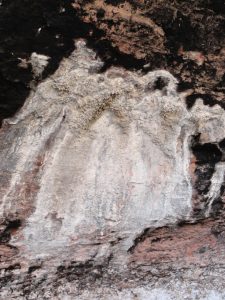 As Uqualla talked about how his people and other indigenous ancestors throughout time honored these sacred places, I asked myself what draws us here in such numbers, to take such pilgrimages, such soul journeys?
As Uqualla talked about how his people and other indigenous ancestors throughout time honored these sacred places, I asked myself what draws us here in such numbers, to take such pilgrimages, such soul journeys?
For many, there is an inexplicable, deep yearning for what we have lost in our civilization: a Knowing, a reflective sense of the sacredness of creation, its cohesiveness and absolute interrelationship.
We are collectively experiencing such profound disintegration of our economic, social and financial foundations, and the breaking down of old structures and beliefs. With surprise and humility, we have become aware of our vulnerability as a species in our relationship to Earth. The fact is, we do not own the Earth, we owe Her our survival.
Our religions have taught us to think of God as a male creator, separate from ourselves. “Western civilization, despite its phenomenal achievements, developed on the foundation of this fundamental split between Spirit and nature—between creator and creation[i]”.
Is this why millions of us are Seekers?
Uqualla reminded me that these physical locations are not the sole doorway into our connection with Spirit. “We were not given all the answers on our life’s journey. At these sacred locations, if approached in the right manner and state of heart, they will bring just a little more illumination and clarity to our earthly walk of becoming better two-leggeds.”
Over our Mayan chocolate, I asked Uqualla whether the voices of the native stewards were being heard as the numbers of Spiritual travellers grew at such phenomenal rate; Sedona being a case in point.
After a contemplative pause, Uqualla said it was time to speak out about proper conduct, about a respectful approach to these sacred sites.
A protocol or etiquette helps us Seekers to connect to the essence of these sacred sites, and to know how to ask for permission to enter and when to leave. Uqualla called this protocol a necessary opening process, which will unfold differently for each individual; it honors both Spirit and the Pilgrims’ own path. Uqualla is a ceremonial ambassador, a cultural steward, a Medicine Man of the land and his people. He decided to take me to a sacred site near Sedona to show me what he meant, and what we had been talking about.
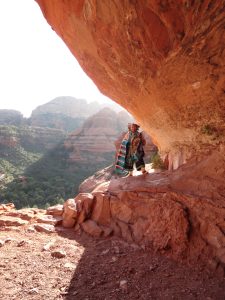 In the early morning on the designated day, Uqualla picked me up and we drove towards Boynton Canyon outside Sedona. The canyon opened up before us into a gorgeous rock-rimmed amphitheater.
In the early morning on the designated day, Uqualla picked me up and we drove towards Boynton Canyon outside Sedona. The canyon opened up before us into a gorgeous rock-rimmed amphitheater.
“Even before you leave for the sacred location, communicate with Spirit. This is part of the process. Long before you get to the actual location, ask yourself why you are going, what it is you want to talk to Spirit about.
Make the connection, do your requests. You are asking for permission to access the sacred site. The moment you do that, communication has been established.
Then watch. Look out for everything around you, watch, listen, look and be aware of your environment. Everything now has a meaning, a significance related to your visit and the reason why you are going. Savor it.
That is a key element for going into these sites: You are opening up to the flow. This is not to be rushed. It is up to you to let your body, your mind, and your heart be peaceful so you may welcome the information that is coming through.”
Not many words were exchanged between us during our drive, until Uqualla said to me: “I have not been here since the time of the 12 sacred moon cycles. The moment now is perfect.
The Canyon is regarded as the birthing canyon to the South West natives. They saw it as the canyon in which the two-legged were birthed from. This ceremonial Spiritual heritage is not specific to a nation. It is the Havasupai creation story, but there are similar legends are alive in all tribes of the area. I am a Keeper, a Steward, a Watcher, a Caretaker of this sacred canyon that has birthed and has given such profound gifting.”
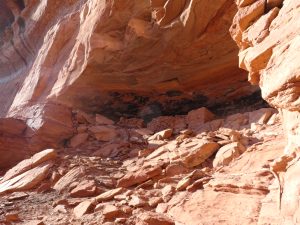 We arrived at the base of a steep rock wall. I looked up, and there, high up, were the ruins of an ancient Sinaguan settlement nestled in a rocky nook.
We arrived at the base of a steep rock wall. I looked up, and there, high up, were the ruins of an ancient Sinaguan settlement nestled in a rocky nook.
We made our way up, quietly and contemplatively. After a long but relatively easy climb, we were close to the crumbling walls of the ruins. Uqualla spoke softly: “Go inwards and sense that your connection has been made with Spirit. You can feel it as a vibration, a thought, a presence.”
When we finally arrived at the entrance to the site, Uqualla stopped and said:“ Before you enter, call out to the Spirits. Don’t rush in. Ask for permission.
Do as you would when visiting; you would not enter a friend’s house without knocking. Make a gesture, express your asking to go ahead in a personal ritual, a movement of some kind: Perhaps you touch a plant, break a small sprig, allow for the aroma to open up and breathe it in. Perhaps you brought a gift you offer now with your prayers. Perhaps you turn several times when asking for permission.
Whatever is right for you and respectful to the sacredness of the site, physical rituals help us two-leggeds to understand “I am in ceremony now”. Those are the simple gestures, different for all of us, that say, “I am now on your watch, I am now requesting an audience”.
As you do so, and anyone after you, the beauty of Spirit shall prevail and touch all those that come here. All that we are telling is very profound.”
I watched Uqualla’s respectful entrance rites and followed with my own.
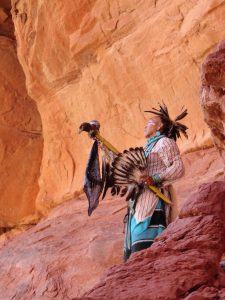 We entered, and the presence of Spirit was strong.
We entered, and the presence of Spirit was strong.
Uqualla had a surprise. He spoke softly: ”I have not been permitted to go further than this place before. This morning Spirit told me that we are both allowed to proceed”; and he pointed to a ledge leading away from the site.
Without hesitation, I followed Uqualla’s moccasin-clad feet along this precariously slanting ledge, carefully placing one foot in front of the other.
Then, exactly midway along the ledge, I dislodged a loose patch of small stones. I listened. It took a long while for the pebbles to hit the ground below, way beyond my view. It was as if an ice-cold hand seized my stomach, my heart raced; I was dead scared. I looked back: there was no going back.
Uqualla meanwhile had continued to move forward, stealthily. I breathed deeply. Then I felt it: a deep calming Knowing that I was here on invitation, I was protected. I need not fear.
With a prayer of gratitude, I let Spirit have my heart, and we climbed on through the remains of another Sinaguan settlement and along a second ledge.
When our feet finally came to rest, I felt intense nausea and my legs shook like leaves. I was to go no further. Uqualla looked at me intently and said: ”I know. I feel it too. We have arrived. We are not to proceed beyond here. I will go a little higher to do ceremony. Stay here.”
Once in place, Uqualla took on a different countenance. He transformed into a ceremonial being. His face alight, he chanted in his native tongue, to Spirit and the ancestors.
The surrounding rock faces answered back with a sonorous echo, the wind whispered, the birds fell silent. A sense of holiness, of presence of Spirit, descended on the land. We felt it, we conversed, and we were blessed and honored to partake.
“And as we speak, we hear the return response of the ancestors. And it was said: Come to this point and listen to what it is that I have given to you.
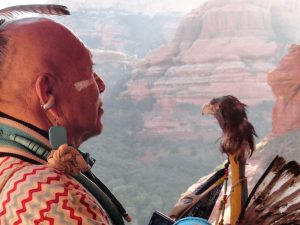 I speak loudly because Spirit has said that I give this to you. We must hear you promise that those who are the Walkers will hear this. They are being asked to walk to sacred places throughout the Mother Earth.
I speak loudly because Spirit has said that I give this to you. We must hear you promise that those who are the Walkers will hear this. They are being asked to walk to sacred places throughout the Mother Earth.
As you come and give your prayers and give your heart and give of your beauty that is within. All that is good of Sprit Creator will again return to the people.
The beauty of the winged ones, as they fly, tell that ascension is in progress. Those that are able to hear are to spread their wings.
But we ask of them to listen with their heart first before they make the visitation to the altars. For not all the altars are ready for them. The ones that are meant for them, they will call out to them. They are not known by name, but by their frequencies and vibrations. They will be in alignment with the frequency of the one that is seeking.
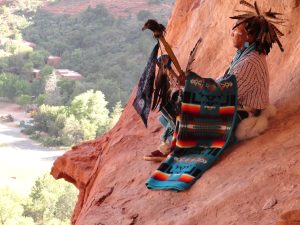
Access into ceremonial altar places is protected. Therefore, if it is that you are not able to go any further, when your body tells you, then that is all you need to experience for now. Listen. We have not taken it away; just put it in reserve for right now until you are ready to partake.
When you come to visit, come see, come feel. When the messages are given, leave. One piece at a time.”
Uqualla and I laid down the gifts we had brought, in reciprocity of what we had received, in gratitude and with deep respect. We thanked Spirit.
“I honor you Great Spirit, I hear you Great Spirit, I thank you Great Spirit, for you have brought me into this place now and given me permission to be able to see and to partake and to know of things that I have not known before.
But within this, words were spoken for all that hear.
Hear it, know it, walk it and allow for all those that hear it and follow in that same way. With this Spirit I thank you, “Ay Hanaha”, it is known for all is good, “Hanaha” all is good, “Hanaha” all is good, “Hanaha”, and all is good!”
It was powerful.
Uqualla James and Eva Willmann de Donlea, 2024
[i] Quoted from Anne Baring http://www.annebaring.com/anbar09_philosophy.htm, “The Real Challenge of Our Times: The Need for a New Worldview”

Etiquette of how to enter sacred sites
© Copyright 2024 1Earth P/L ta Lifeforce Matrix